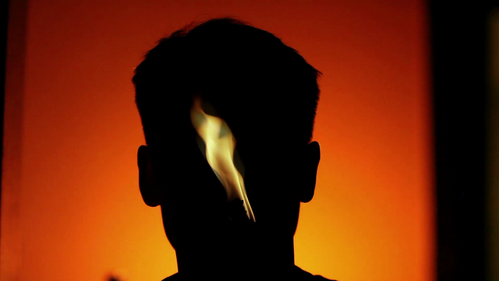The HD video installation Death Mask III (2011) by Ed Atkins is one of a series of works in which the artist explores the representation of death and the loss of materiality in digital moving images. “Industrial cinema is pushing for high definition and 3-D, and, at the same time, the body of cinema — as a tangible thing — is dissolving: there is no celluloid, no tape, no DVD. All that remains are these scraps of code that, in part, simply haunt various media,” explains the British artist. “You have this seemingly immaterial aspect, which for me is an echo of the dead body, which is both present and utterly absent.” When Atkins started to work on the series, his father died, so that his own experiences of death and loss flow into the work as well.
Death Mask III begins with the view from a window of a moving ship, looking out onto the gray and desolate sea passing by. This is followed by sequences of a man gazing into a flickering fire, accompanied by electronic music, and shots of the landscape surrounding the mountains on La Gomera — shrouded in fog — and of banana leaves in the sunlight. There is no narrative connection between the individual sequences and — if something akin to a contemplative mood develops—this is swiftly interrupted by short monochrome black, white and color screens, banners with text fragments and abruptly changing audio. In between, flashbacks flicker in black and white — as in a horror film. Death Mask III emerges like a hot feverish dream in which the experienced mixes with the imagined, dream with reality and fears with longings.
Ed Atkins (*1982) belongs to a younger generation of artists who critically examine the changing image of humans and their self-perception in an era shaped by digital media. He became known for his artificial, hyper-rea-looking imagery, in which avatars touch the emotions of the viewer. With his technically sophisticated and aesthetically appealing images, Atkins addresses existential human experiences such as loneliness, alienation, loss and death in the post-internet era.




















